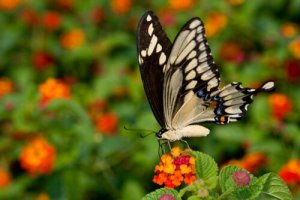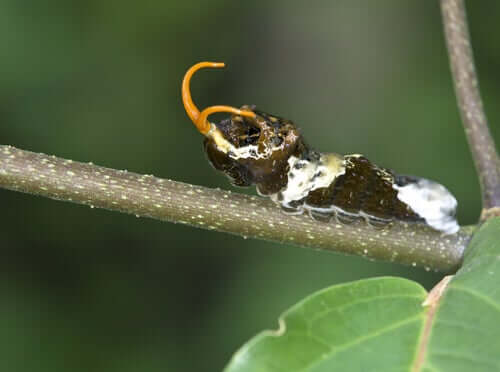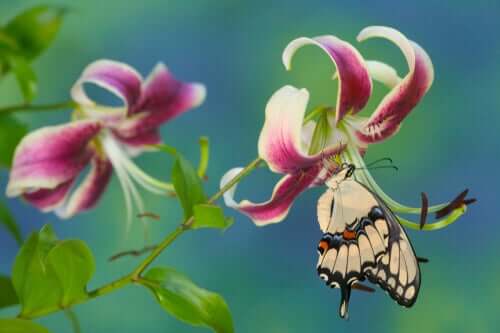The Giant Swallowtail: The Biggest and Most Exotic Butterfly

The giant swallowtail or Papilio cresphontes is an amazing butterfly. It looks very exotic and is found in large numbers across North and South America. The adult is a welcome visitor in gardens, plantations, and other landscapes.
The larvae or caterpillar stage can be considered to be a pest because it tends to feed on the leaves of most Citrus species. In fact, some larvae can strip the leaves off small or young plants rapidly. However, large citrus trees can tolerate the larvae.
Geographic distribution of the Giant Swallowtail
This specimen is widely distributed throughout North and South America. You can find them anywhere from southern New England through the northern states of the Great Lakes to Ontario or across the southern Central Plains to the Rocky Mountains.
This species also extends south to the Caribbean, the southwest of the United States, and through Mexico to Central and South America. The giant swallowtail is particularly common in the state of Florida.
Morphological characteristics
The male adult giant swallowtail can reach an average of some 5.5 inches in length whist the female can reach about 6 inches. The dorsal surfaces of this butterfly’s wings are black with a striking diagonal yellow bar across the hind wings.
On the other hand, the ventral surfaces of its wings are mainly yellow. The tail has the shape of a swallow’s wings and may vary in color depending on the geographical location. Some tails are completely yellow, others are all black, and some are more bright red just with a blue band at the end of the hind wing.

The five larval stages differ in appearance, but they all look similar to bird droppings. The youngest larvae look like the most realistic bird feces because of their smaller size.
Mature larvae generally rest on leaf stems or stalks, but younger larvae can often be seen with the naked eye on the upper surface of leaves. This latter larvae are mainly black or brown with a white stripe and have prominent ‘hairs’.
Life cycle
The adult giant swallowtail drinks nectar from many different flowers and it’s a common sight in spectacular gardens containing azaleas, bougainvillea, Japanese honeysuckle, goldenrods, and milkweed. It can also drink the fluids from manure.
Adult males patrol migratory routes through pine forests or citrus orchards looking for females. Their flight is strong and slow and they can travel long distances. Courtship and mating occur in the afternoon.
Paired females generally lay their eggs individually on the upper surface of the leaves of host plants. Their eggs are spherical, measure 1 to 1.5 mm in diameter and have a creamy brown color. Typically, they’re unevenly coated in an orange secretion which is similar in appearance to orange peel.

Larvae can undergo their metamorphosis on small twigs of the host plant or they can travel a short distance to a vertical structure, such as a fence or another plant. The brownish chrysalis normally has 45° orientation with respect to the pupation substrate. At least two, and sometimes three, generations go through the cycle each year in Florida.
Biological control
The giant swallowtail larva is considered to be a minor pest for sweet oranges, and larvae host plants include members of the citrus family, white sapote, and other exotic plants.
The pupae are immobile and defenseless against parasitic insects. The larvae stages appear to be better protected against enemies than the pupae stage. The larvae defend themselves against predators, both insects and invertebrates, and against parasitic insects because they are harder to see due to their color and pattern – they look like bird droppings.
Furthermore, the larvae have a gland in the middle part behind the head that they can use when attacked by small predators. This gland secretes very harmful spicy chemicals that smell like rancid butter. This secretion is a repellent and poisonous for predators such as ants and spiders.
The giant swallowtail or Papilio cresphontes is an amazing butterfly. It looks very exotic and is found in large numbers across North and South America. The adult is a welcome visitor in gardens, plantations, and other landscapes.
The larvae or caterpillar stage can be considered to be a pest because it tends to feed on the leaves of most Citrus species. In fact, some larvae can strip the leaves off small or young plants rapidly. However, large citrus trees can tolerate the larvae.
Geographic distribution of the Giant Swallowtail
This specimen is widely distributed throughout North and South America. You can find them anywhere from southern New England through the northern states of the Great Lakes to Ontario or across the southern Central Plains to the Rocky Mountains.
This species also extends south to the Caribbean, the southwest of the United States, and through Mexico to Central and South America. The giant swallowtail is particularly common in the state of Florida.
Morphological characteristics
The male adult giant swallowtail can reach an average of some 5.5 inches in length whist the female can reach about 6 inches. The dorsal surfaces of this butterfly’s wings are black with a striking diagonal yellow bar across the hind wings.
On the other hand, the ventral surfaces of its wings are mainly yellow. The tail has the shape of a swallow’s wings and may vary in color depending on the geographical location. Some tails are completely yellow, others are all black, and some are more bright red just with a blue band at the end of the hind wing.

The five larval stages differ in appearance, but they all look similar to bird droppings. The youngest larvae look like the most realistic bird feces because of their smaller size.
Mature larvae generally rest on leaf stems or stalks, but younger larvae can often be seen with the naked eye on the upper surface of leaves. This latter larvae are mainly black or brown with a white stripe and have prominent ‘hairs’.
Life cycle
The adult giant swallowtail drinks nectar from many different flowers and it’s a common sight in spectacular gardens containing azaleas, bougainvillea, Japanese honeysuckle, goldenrods, and milkweed. It can also drink the fluids from manure.
Adult males patrol migratory routes through pine forests or citrus orchards looking for females. Their flight is strong and slow and they can travel long distances. Courtship and mating occur in the afternoon.
Paired females generally lay their eggs individually on the upper surface of the leaves of host plants. Their eggs are spherical, measure 1 to 1.5 mm in diameter and have a creamy brown color. Typically, they’re unevenly coated in an orange secretion which is similar in appearance to orange peel.

Larvae can undergo their metamorphosis on small twigs of the host plant or they can travel a short distance to a vertical structure, such as a fence or another plant. The brownish chrysalis normally has 45° orientation with respect to the pupation substrate. At least two, and sometimes three, generations go through the cycle each year in Florida.
Biological control
The giant swallowtail larva is considered to be a minor pest for sweet oranges, and larvae host plants include members of the citrus family, white sapote, and other exotic plants.
The pupae are immobile and defenseless against parasitic insects. The larvae stages appear to be better protected against enemies than the pupae stage. The larvae defend themselves against predators, both insects and invertebrates, and against parasitic insects because they are harder to see due to their color and pattern – they look like bird droppings.
Furthermore, the larvae have a gland in the middle part behind the head that they can use when attacked by small predators. This gland secretes very harmful spicy chemicals that smell like rancid butter. This secretion is a repellent and poisonous for predators such as ants and spiders.
All cited sources were thoroughly reviewed by our team to ensure their quality, reliability, currency, and validity. The bibliography of this article was considered reliable and of academic or scientific accuracy.
- https://ypte.org/factsheets/butterfly-swallowtail/overview#section
This text is provided for informational purposes only and does not replace consultation with a professional. If in doubt, consult your specialist.








